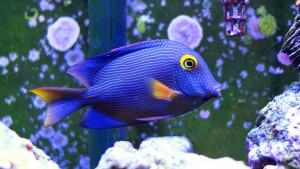Among the so-called bristletooths of the genus Ctenochaetus is one of my favorite tang species and one that I highly recommend to other hobbyists with well-established, medium-sized to moderately large systems—the Kole tang (Ctenochaetus strigosus).
Physical traits
C. strigosus, which is also sold under the common names yellow-eye tang, gold-ring bristletooth, and several others, has an ovate, laterally compressed body. Adults are brownish overall (juveniles are more yellowish) with numerous thin, horizontal, light-blue stripes on their flanks; tiny light-blue spots on the head and throat; a neon-blue margin on the dorsal and anal fins; and a bright-gold ring around each eye. Depending on where they’re collected, some specimens may be mostly spotted instead of striped. The maximum recorded size for this species is about 7 inches.
The term “bristletooth” refers to the comb-like teeth this species and its congeners use to graze and forage. In fact, loosely translated, the generic name Ctenochaetus means “comb bristle.”
Feeding
In nature, C. strigosus feeds largely on detritus and microalgae—hence the preference for keeping this species in well-established tanks. Newly set up systems may be too “sterile” to support its constant grazing habits. In addition to naturally occurring flora, these tangs should be offered a variety of algae-based foods, such as frozen formulations for herbivores and dried marine algae sheets/flakes. They’ll also happily accept meaty foods, but don’t let that lull you into being stingy with the greens.
Housing
I wouldn’t go with anything less than a 75-gallon aquarium for C. strigosus. That’s about as small as you can go while still providing a reasonable balance between open swimming space and live rock to graze upon. Again, let the system get well established before introducing a Kole tang.
Also keep in mind that C. strigosus favors highly oxygenated water and low dissolved-nutrient levels, so brisk water movement, copious water changes, and vigorous protein skimming are in order.
Tankmates
C. strigosus can, perhaps, best be described as “semi-aggressive.” It’s generally peaceful toward most other fish but may fight with those that are too similar in shape, dietary preferences, or the niche they occupy. Other tangs are likely to be viewed as the most direct competitors/targets of ire—or, if more aggressive, to bully the Kole tang. Also, conspecifics are unlikely to cohabit peacefully, so it’s best to keep C. strigosus one specimen to a tank.
Reefkeepers will find that C. strigosus is a worthy addition to a suitably sized system. It won’t harm sessile invertebrates and can help keep microalgae growth in control through its constant grazing.



